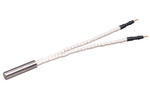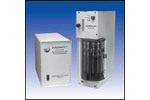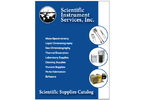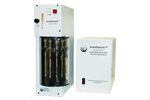- ▶
- Heaters/Source
- ▶
- Agilent Heaters and SensorsMass Spectrometry, Scientific Supplies & ManufacturingScientific Instrument Services 5973 Source Heater Tamper Resistant Allen Wrench 5973/5975 Quad Sensor 5985 Source Heater Assembly Agilent Interface Heater Assembly 5971 Interface Heater

- ▶
- TD
- ▶
- AutoDesorb (12 sample)
- Print Catalog
- ▶
- Catalog Page C1Short Path™ Thermal Desorption TD-5 [C2] Short Path™ Thermal Desorption TD-5 [C3] Short Path™ Thermal Desorption System TD-5 [C4] Short Path™ Thermal Desorption TD-5 [C5] AutoDesorb™ [C6] AutoDesorb™ [C7] AutoDesorb™ [C8] AutoDesorb™ [C9] Short Path™ Thermal Desorption Tubes [C10] Desorption System Fittings [C11] TD1/TD2/TD3/TD4/TD5/ Needles & Seals [C12] AutoDesorb™ Needles, Seals & Connecting Tubes [C13] Adsorbent Resin for Trapping Volatiles [C14] Adsorbent Resin for Trapping Volatiles [C15] Thermal Desorption Conditioning System [C16] Thermal Desorption Conditioning System [C17] Heated Thermal Desorption Sampling Chambers [C18] Extraction Cell for Papers, Polymers & Food Containers [C19] Thermal Desorption Sample Collection System [C20] Thermal Desorption Sample Collection System [C21] Cryo-Trap™ for TD-5 [C22] Cryo-Trap™ for the AutoDesorb™ System [C23] Purge & Trap System [C24] Temperature Controller & Heater Sleeves [C25] Thermal Desorption Accessories [C26] Thermal Desorption Low Flow Air Sampling Pump [C27] Gilibrator™ Air Flow Calibration System [C28] Gilibrator™ Air Flow Calibration System [C29] ALTEF Gas Sampling Bags [C30]

- ▶
- Catalog Page C7 (This Page)
C7
AutoDesorb™
FAX: 908-806-6631
www.sisweb.com
Ready
Load Sample
Sample Loaded
Heat Blocks
Cool Cryo-Trap
Purge Gas ON
Injecting
Injection Complete
Desorbing Sample
Desorption Done
Sample Analysis
Unload Sample
T
he AutoDesorb System sits on top of the GC
injection port of a Agilent Technologies 7890, 6890
or 5890 GC, where it is utilized for the direct ther-
mal desorption of both volatile and semi-volatile samples into
the GC injection port and subsequently onto the GC column.
It is NOT permanently mounted to the GC. It is held in place
by gravity and can be lifted up and removed in seconds to
restore the GC to its normal operation. The only modification
to the GC is the addition of a carrier gas shut-off valve which
does not effect the normal operation of the GC. The GC can
be returned to normal GC operation in seconds.
The SIS™ AutoDesorb system is controlled by a PC
Windows software program that is integrated with the Agilent
ChemStation™ GC or GC/MS program to control the
automatic injection, timed desorption, multi-step temperature
ramp of heater blocks, control of GC Cryo-Trap accessory,
and remote starting of the GC and Mass Spectrometer (see
page C10).
The standard desorption tubes are reusable Silco Coated
Stainless Steel Desorption Tubes which have an I.D of 3.0
mm, are 4.0" long by 1/4" diameter and are threaded on both
ends.
The inside of the desorption tube is lined with glass to
provide an inert environment for sample. Samples to be ana-
lyzed are collected on the desorption tubes containing an
adsorbent resin such as Tenax™ TA or activated carbon.
Alternatively, samples of small size (1 to 500 mg) can be
packed directly into the desorption tube.
The ends of the
tubes can be fitted with stainless steel caps with seals to
maintain sample integrity during sample storage.
When ready for analysis, the thermal desorption tube is
attached to a connecting tube and the desorption needle is
attached. This connecting tube is the adapter that enables the
desorption tube to be attached to the AutoDesorb carousel for
thermal desorption analysis. The top of the connecting tube
contains a spring loaded sealing ball to seal the desorption
tube and maintain sample integrity until the actual thermal
desorption process begins.
The thermal desorption tube is then loaded into the
AutoDesorb system carousel.
Up to 12 desorption tubes can
be loaded into the carousel (1). Tubes can be continuously
loaded and unloaded during the running of the sample
sequence.
The Agilent ChemStation software is set up with the GC
or GC/MS method and the desorption method is setup on the
AutoDesorb windows. When the sample run is initialized on
the ChemStation Window, the desorption tube is
automatically loaded in the pickup mechanism (2 & 3). The
desorption heater blocks are preheated to their initial
temperature (4) and the cryo-trap cooled to its preset
temperature (5). The carrier gas through the desorption tube
is turned on and the flow can be manually adjusted via the
flow controller to between 1.0 ml/min and 120 ml/min for an
initial purge time (6).
The desorption tube is then injected into the GC injection
port.(7 & 8) If there are no leaks detected, the desorption
blocks close around the desorption tube and the desorption
tube will ballistically heat up
(or temperature ramp) to the set
temperature or the temperature program ramp for the heater
blocks will begin (9). The combination of the heat applied and
the carrier gas flow through the Desorption Tube will purge
the desired components into the GC injection port and onto
the front of the GC column.
Normal desorption times vary from 3 minutes to 15
minutes. The analytes are thermally desorbed from the
adsorbent resin and injected directly into the injection port of
the Gas Chromatograph via the shortest path possible, i.e
direct injection into the GC much like a syringe.
The desorbed compounds of interest are trapped on the
front of the GC column in a narrow band utilizing GC oven
cooling or the optional GC Cryo-Trap™ Accessory. Despite the
long desorption times, the peaks eluted from the column are
extremely sharp and well resolved.
When the sample has been fully desorbed into the GC
column, the desorption blocks are opened (10), the sample is
uninjected from the GC injection port (11), the Cryo-Trap is
heated to release the analytes from the Cryo-Trap and the
GC is started by the AutoDesorb system. The GC
temperature programming is commenced to elute and
separate the analytes into the desired components. The
purge gas remains on for 5.0 minutes to cool the desorption
tube and then the sample is unloaded back into the
AutoDesorb carousel (12).
When the GC analysis is complete, the next sample of
the ChemStation™
sequence is loaded, the GC and
AutoDesorb system parameters are reset and this next
sample is analyzed.
AutoDesorb Sequential Operations
Theory of Operation of the AutoDesorb System
D
e
s
o
rp
ti
o
n
T
u
b
e
N
e
e
d
le
S
e
a
li
n
g
B
a
ll
C
o
n
n
e
c
ti
n
g
T
u
b
e
D
e
s
o
rp
ti
o
n
T
u
b
e
 Table of Contents
Table of Contents
(Print Catalog)Table of Contents of the Scientific Instrument Services general catalog volume 36. Print Catalog C. Short Path™ Thermal Desorption SIS Vol. 36 catalog Section C - Short Path™ Thermal Desorption.
Print Catalog C. Short Path™ Thermal Desorption SIS Vol. 36 catalog Section C - Short Path™ Thermal Desorption.AutoDesorb™
(Catalog C6)AutoDesorb™
(Catalog C7)AutoDesorb™
(Catalog C8)


